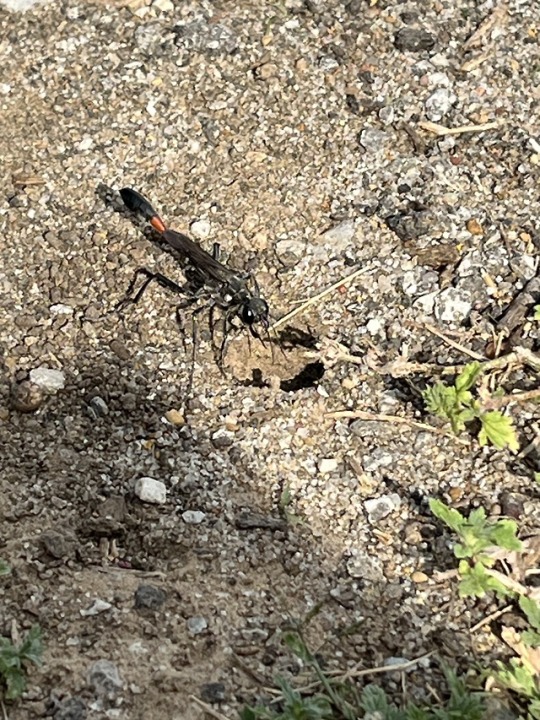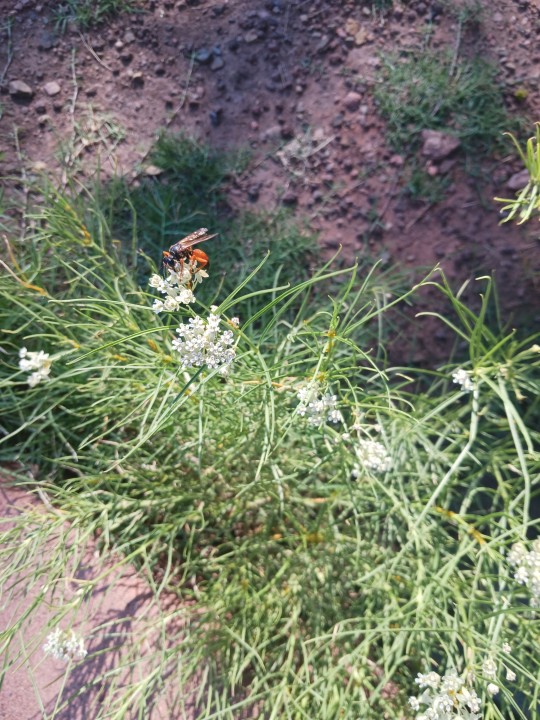#genus Ammophila
Explore tagged Tumblr posts
Text
Beautiful Ammophila pectipennis Wasps Love the Nectar of Fall Wildflowers
Wasp with an Appetite. Until 2023, I had never seen, or at least never noticed these beautiful Ammophila pectipennis wasps. They’re supposed to be fairly uncommon and don’t even have a common name. Since 2023, I’ve seen quite a few of them, especially in the fall. I haven’t seen as many this fall as I did last fall, but there are still quite a few, particularly on the blackjack flowers. I love…
#Ammophila pectipennis#Ammophila pectipennis wasps#Ammophila wasps#beautiful insects#black and red wasps#colorful insects#colorful wasps#fall wasps#Florida insects#Florida wasps#genus Ammophila#insect photographs#insect photography#insects#large insects#solitary wasps#thin wasps#wasp photography#wasps feeding#wasps photographs
0 notes
Photo

Spinch (c**********[email protected]) submitted: hello! this little fella was digging a hole by my bus stop out in oklahoma and my friend said it might be a mud dauber of sorts! was she perhaps correct?
Hi! This lovely lady is a thread-waisted wasp in the genus Ammophila - probably Ammophila procera. This species digs nests in the ground, so she is not a mud dauber. Mud daubers use mud to create nests on surfaces.
57 notes
·
View notes
Text


Some type of thread-waisted sand wasp! Ammophila is the genus. iNaturalist had three different species guesses that all looked identical to me. If you feel confident you can identify it, here's the observation link! Seen on 5/19/2024 in central Illinois.
#bugs#bugblr#insects#insect#bug#entomology#oc#iNaturalist#wasp#wasps#hymenoptera#ammophila#sphecidae
18 notes
·
View notes
Text
She is a thread-waisted wasp!
The name thread-waisted wasp refers to an entire family of wasps (Sphecidae) but also commonly refers specifically to this little one. Her genus is Ammophila, though I’m not sure of the species!
She and her fellow thread-waists are delightfully elegant and elusive, and by far my favorite wasps.



wake again after rest
12K notes
·
View notes
Text
Awkward Botanical Sketches #5: Leaves of Yellowstone Edition
Awkward Botanical Sketches #5: Leaves of Yellowstone Edition
Earlier this month, I met up with Eric LoPresti and others at Yellowstone National Park to help take a census of Abronia ammophila, a rare plant endemic to the park and commonly referred to as Yellowstone sand verbena. Abronia (a.k.a. the sand-verbenas) is a small genus of plants in the family Nyctaginaceae that is native to western North America. Several species in the genus have fairly limited…

View On WordPress
#Abronia#Abronia ammophila#Awkward Botanical Sketches#botanical illustration#Botany#colored pencil#drawing#endemic plants#Eric LoPresti#flowers#Fragaria#Geranium#leaves#Nyctaginaceae#pencil drawings#Pinus contorta#plant conservation#Potentilla#rare plants#Rumex#sand verbena#seedling#Yellowstone National Park#Yellowstone sand verbena
12 notes
·
View notes
Link
Ammophila (synonymous with Psamma P. Beauv.) is a genus of flowering plants consisting of two or three very similar species of grasses. The common names for these grasses include marram grass, bent grass, and beachgrass. These grasses are found almost exclusively on the first line of coastal sand dunes. Their extensive systems of creeping underground stems or rhizomes allow them to thrive under conditions of shifting sands and high winds, and to help stabilize and prevent coastal erosion. Ammophila species are native to the coasts of the North Atlantic Ocean where they are usually the dominant species on sand dunes. Their native range includes few inland regions, with the Great Lakes of North America being the main exception. The genus name Ammophila originates from the Greek words ἄμμος (ámmos), meaning “sand”, and ϕιλος (phillia), meaning “lover”.
0 notes
Text
Just Another Beautiful Ammophila Wasp
Just Another Beautiful Ammophila Wasp shows readers a macro photo of this fairly uncommon Florida wasp. It explains that although they are generally uncommon the author/artist has encountered them frequently this year.
Tiptoe Through the Sumac These guys are fairly uncommon wasps, and I had never seen one before this spring. They’re uncommon enough that they don’t even have a common name, just Ammophila pectipennis. I guess they have liked our unusual weather this year because I’ve been seeing them all over all this summer. They’re very pretty and quite docile, so I’m happy to have another pollinator in the…

View On WordPress
#Ammophila pectipennis#Ammophila photographs#Ammophila wasps#beautiful wasps#black and red insects#black and red wasps#colorful wasps#Florida insects#Florida wasps#genus Ammophila#insect photographs#insect photography#insects#large wasps#photography#pollinators#uncommon insects#uncommon wasps#wasp photographs#wasp photography#wasps
0 notes
Text
Beautiful Ammophila pectipennis is an Uncommon Florida Wasp
Beautiful Ammophila pectipennis is an Uncommon Florida Wasp shows readers several photos of this uncommon, solitary wasp. It also gives a few facts about them and other thread-waisted wasps, and explains the author/artist’s encounter with this wasp.
Thread Waist I was very excited to find this relatively uncommon wasp feeding in the wildflowers that grow behind our office. I sometimes go out there because there are always quite a few pollinators out and about. The numbers and type vary with the season and the weather, but I’ve never been totally disappointed when I’ve gone back there. This latest trip led to the discovery of this new…

View On WordPress
#Ammophila pectipennis#beautiful wasps#black and yellow wasps#colorful wasps#Florida insects#Florida pollinators#Florida wasps#garden wasps#genus Ammophila#insect photographs#insect photography#insects#photography#pollinators#solitary wasps#spring wasps#thread-waisted wasps#uncommon wasps#wasp photographs#wasp photography#wasps
0 notes
Text
@clover-soup-art submitted: A dear friend spotted this large lad in (please remove location: [removed]) hauling a grub. Who is she?

Ohhh RIP to the caterpillar. This friend appears to be one of the thread-waisted sand wasps in the genus Ammophila. They will paralyze caterpillars to bring to their larvae :)
#animals#insects#bugs#submission#wasp#thread waisted wasp#thread waisted sand wasp#Ammophila#bug death#predation#injured bug#caterpillar#larva
83 notes
·
View notes
Text
@goodluck-milo submitted: I was up in Pine, AZ over labor day weekend looking for Dynastes grantii and I only found 1 but I also found a Xyloryctes thestalus couple and lots of other fun bugs!! Here are some ones I got good pictures of to identify. There was a large mystery bug I kept seeing around but I never got a good picture for ID.

A wasp with a caterpillar victim. Not sure if it’s the paralyzing kind or the egg-injecting kind 🤔

Another mystery wasp polinating some flowers. This one was very big!

A small bee I found in the ashes of our fire pit when I was preparing a fire!

And a cute pink and yellow moth

And this lil guy who landed right on me! I’m thinking three-lined potato beetle for this one but I’m not sure.
Enjoy the bugs! Thank you for bringing wonderful crawlies to my feed.
How exciting you got to see a few rhinoceros beetles! They’re always fun to see. The first wasp on the caterpillar appears to be one of the thread-waisted sand wasps in the genus Ammophila. They will paralyze their prey and bring it back to their nest for their larvae to nibble after they hatch out of their egg.
The second large wasp pal looks like a great golden digger wasp or similar in the same genus, Sphex. The bee is very tiny and precious but I am terrible at IDing bees so I’m not even gonna attempt it. The cute moth is a tiger moth in the genus Apantesis, and the last stripey beetle fellow could be a three-lined potato beetle, but there’s another very similar species that it also could be - the three-lined Lema beetle, Lema trivattata. Thanks for sharing!
#animals#insects#bugs#submission#wasp#thread waisted wasp#thread waisted sand wasp#Ammophila#great golden digger wasp#Sphex#bee#moth#tiger moth#Apantesis#beetle#Lema#long post
65 notes
·
View notes
Text




@guardianofreaks submitted: I think this is a Spider Wasp but I'm not sure
Oshawa, Ontario, Canada
A lovely goth friend! This looks like a wasp in the Ammophila genus to me, and they generally catch caterpillars and sawfly larvae for their own larvae to eat. :)
43 notes
·
View notes